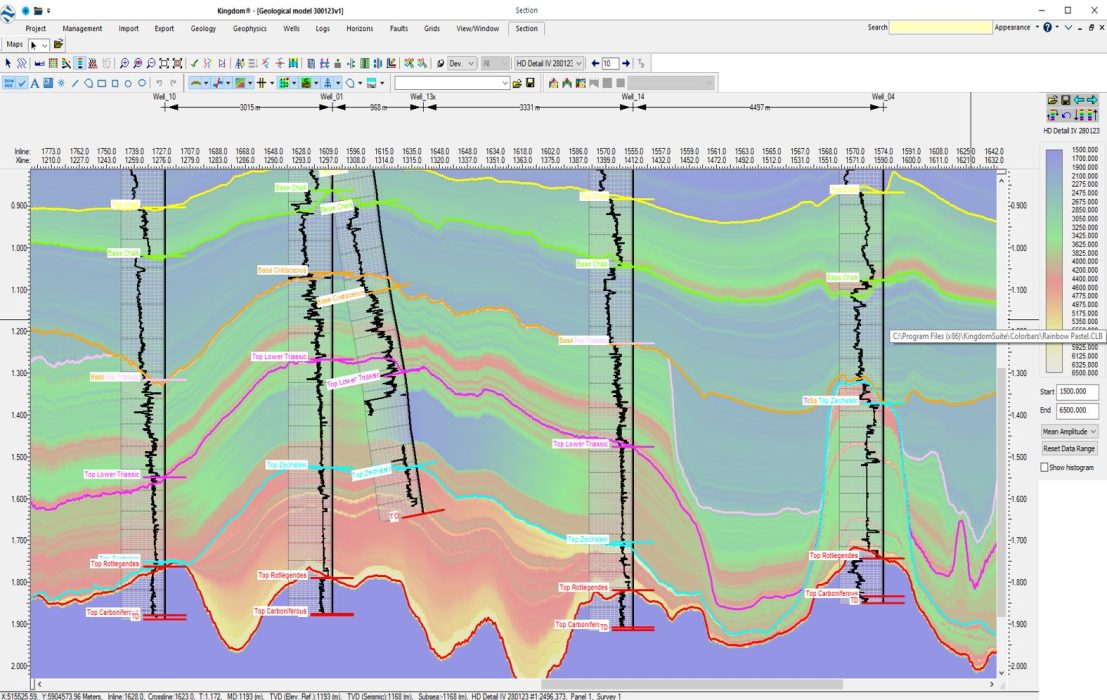
Get a Free Demo
Contact us for a free demo
LogToVolume – Available Free for VelPAK and Kingdom Seismic Inversion users
 LogToVolume uses the current TKS project and generates highly detailed volumes from a background velocity model, well velocity logs and geological interpretation. Well log velocities are propagated in a volume consistent with geological and interval velocity constraints, tying the volume to well logs.
LogToVolume uses the current TKS project and generates highly detailed volumes from a background velocity model, well velocity logs and geological interpretation. Well log velocities are propagated in a volume consistent with geological and interval velocity constraints, tying the volume to well logs.
It produces a sophisticated, high-definition volume that can be used for depth conversion, in addition to attribute analysis, reservoir characterisation studies and input for seismic inversion packages.
The easy-to-use Wizard guides you through the process to quickly generate all the volumes and grids you want!
Geologically Consistent Models
 Here you see an example of the same profile with the geological behaviour of the middle layer having been changed within LogToVolume.
Here you see an example of the same profile with the geological behaviour of the middle layer having been changed within LogToVolume.
The geological behaviour of each layer is defined by assigning each layer one of three spread types: Cut from Top, Cut from Base or Stretch and Squeeze. When the process is run, the layers are flattened onto a datum, processed and then returned to the original layer structure.
Cut from Top –The layers remain parallel to the base but cut at the top. Here the red velocity is drawn down to be parallel to the base of the layer.
Cut from Base – The layers remain parallel to the top but are cut at the bottom. Here the red velocity remains parallel to the top of the layer.
Stretch and Squeeze – A Well will be squeezed or stretched to fill the layer horizon regardless of width of layer. Here you see the red velocity being stretched where the layer goes thick.
As you can see from these examples the volumes produced can look very different depending on which spread type you choose. Note that it is the user who is expected to have the geological knowledge of the area in order to make the correct selection of cut type.
Depth Conversion in LogToVolume
 The Depth Conversion part of LogToVolume produces corrected velocity volumes, depth grids and other associated grids. It can also depth convert existing volumes and convert existing volumes between time and depth, interval and average velocity.
The Depth Conversion part of LogToVolume produces corrected velocity volumes, depth grids and other associated grids. It can also depth convert existing volumes and convert existing volumes between time and depth, interval and average velocity.
The software also permits you to view any of the data you have created, as well as post information on the maps for each of the layers all selected from the model tree.
Generated grids are synchronised with the relevant data with Kingdom. The program is tightly linked with Kingdom such that the data is then immediately visible in the Kingdom tree.
Volume Creation in LogToVolume
 The final step in the process is the volume creation. This takes a volume in the time domain and uses a velocity volume to convert the volume to the depth domain. For example, an amplitude volume in the time domain could be converted to an amplitude volume in the depth domain.
The final step in the process is the volume creation. This takes a volume in the time domain and uses a velocity volume to convert the volume to the depth domain. For example, an amplitude volume in the time domain could be converted to an amplitude volume in the depth domain.
When the volume has been processed, you will then be able to access it in Kingdom as the seismic volume in the depth domain. In the image here you can see that the velocity volume is displayed over the seismic, which is a robust depth conversion tying the wells at all locations. You can also see that the velocities within the layers encompass the geological complexity of the data, thus ensuring a very reliable result.
Please note this module is not yet available on the Petrel platform.
